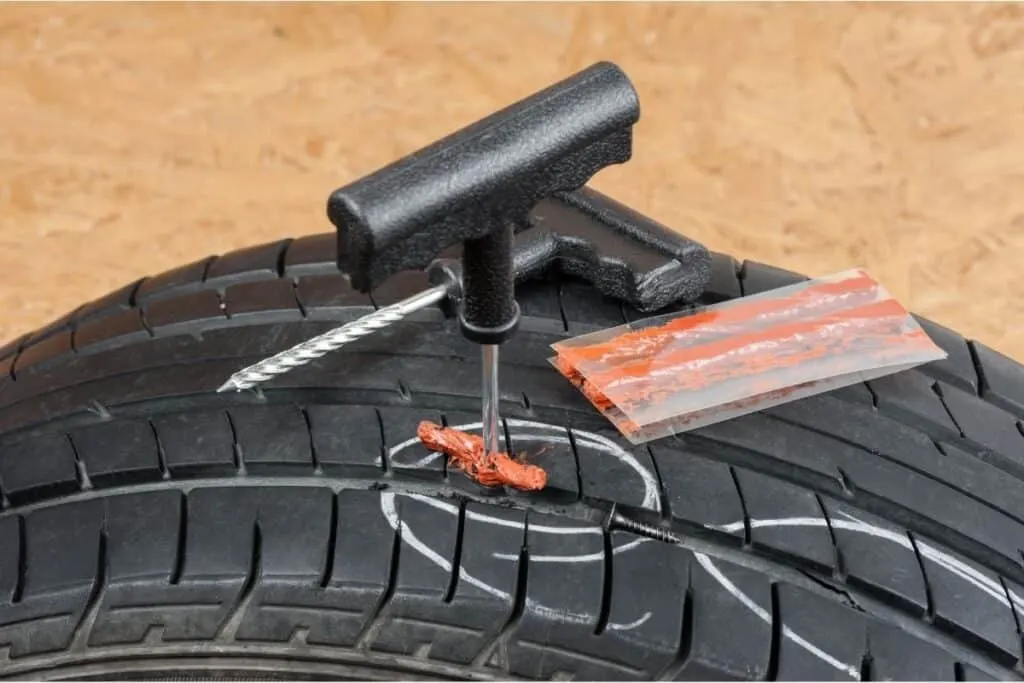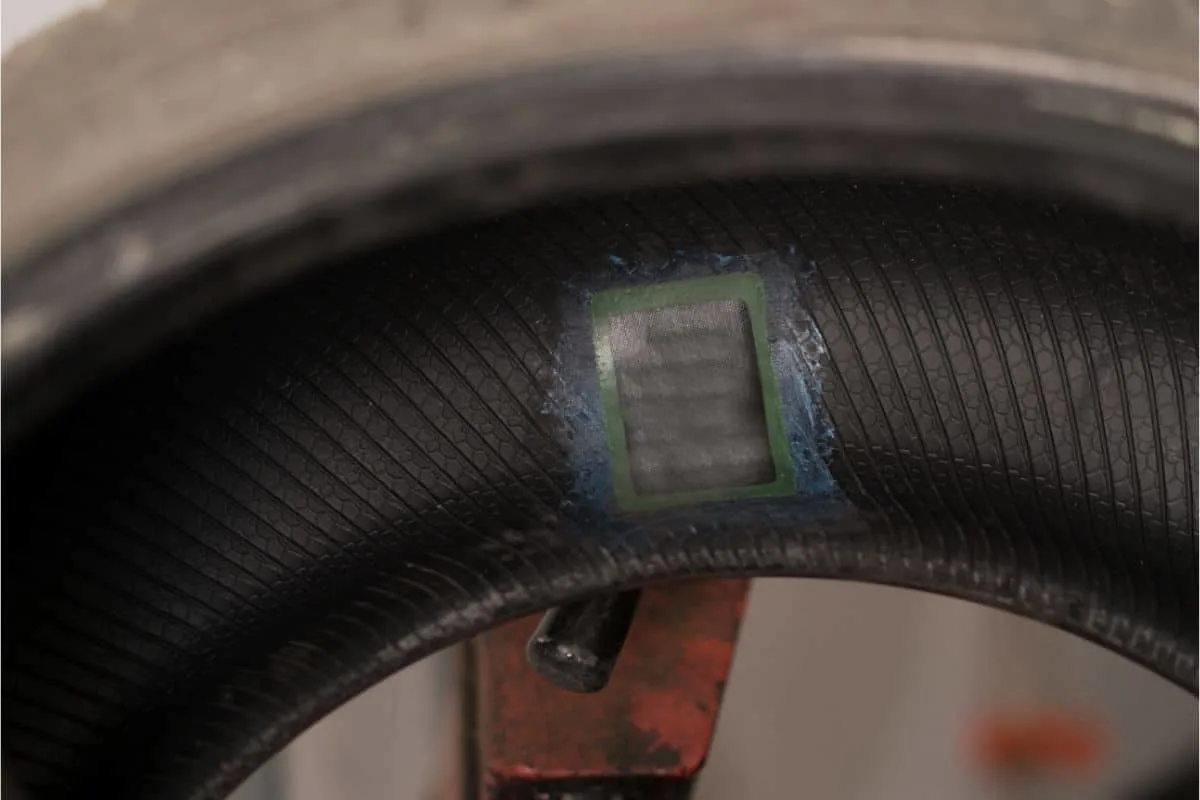Getting a flat tire is unfortunately very common and shouldn’t be considered a big deal. There are two methods of fixing a flat tire, both of which are fast and relatively cheap. Tire patching or plugging is what most people use to fix holes on their wheels.
The Average Cost to Get a Tire Patched (Kit vs. Shop)
Most service stations and auto repair shops charge $25 on average for a tire patch and a realignment. While you can perform this repair on your own for less using a kit, it will require additional tools that you may not have available.
Some shops will charge $20 or less, while other shops might do it for free if you got your tires from them.
If you are lucky and caught the puncture early, some auto repair shops charge you anywhere between $15-$30. There might be additional charges such as a tire sealant which costs around $10-$15. Sealed tires typically last less than100 miles only, making it a temporary solution.
Alternatively, you can do it yourself with a repair kit which costs anywhere from $5-$20. This kit contains only the essentials such as simple tools, plugs and gear you need to do the repatch yourself. A bigger kit includes a pump for reinflating a flat tire and sealant, which will set you back averagely $20-$50.
Whichever method you choose, we shall get into details on the tire repair methods and the advantages or disadvantages. Continue reading to understand what happens after you get a flat tire.
When to Patch a Tire Versus When to Replace It
Repairable Tires
You can repair a tire if:
- The puncture hole is located within a tire’s puncture repair area, between the treads. The USTMA and TIA guidelines prohibit the repair of a tire’s shoulder and sidewall.
- If the puncture hole is less than ¼ of an inch in diameter
- The puncture hole doesn’t coincide with previous repair locations and isn’t across from each other
How to Repair a Tire Using a Patch
- Separate the tire from the rim
- Inspect the tire thoroughly on the outside as well as the inside. Whatever caused the puncture might have damaged the interior sidewall if it went in deep enough.
- After inspection, you can determine if the tire can be repaired or not. If it can, you trim to remove damaged cables from the puncture site to clean and stabilize it.
- Pull a rubber stem from the inside out through the puncture site to seal off the inside of the tire.
- Buff the puncture site from the inside and apply a special vulcanizing glue.
- Install a patch over the inner lining over the puncture site. The patch and the glue will cause a chemical reaction, sealing the hole.
- Mount the tire back on the rim and inflate the tire to its proper pressure. Don’t forget to look for leaks from your repair site.
This procedure typically requires 60-90 minutes to be done correctly.
Non-repairable Tires
Some damages to the tires are too severe, making the tire irreparable. The location of the puncture hole can also make safe tire repair impossible. You can’t repair a tire if:
1. The Puncture Hole Falls Outside The Repair Area
As discussed, any hole outside the Puncture Repair Area is regarded as irreparable. Repairs are mostly limited to the middle and crown of the tire.
The crown refers to the center of the tread, 1 to 1.5 from each tire’s shoulder. Most tires specify that their puncture repair area is within the outermost major grooves on both shoulders.
2. The Size Of The Puncture Hole
Passenger vehicles and light truck tires have a maximum repairable injury size of 6mm or ¼ inch diameter. If the puncture hole is more significant than this size, the tire should be replaced.
3. Bubble Or Bulge In The Sidewall
A noticeable bubble or bulge in the sidewall comes as a result of the high impact of the tire on a pothole, curb, and other types of road hazards. The bulge or bubble cannot be reversed, which means that the tire must be replaced.

Tire Plug vs. Tire Patch
What Is a Tire Plug?
A tire plug is a large piece made of malleable rubber inserted on the outside of the tire into a puncture hole. It expands and prevents air trapped in the tire from escaping through the hole.
They take a short time to install because they don’t require the tire to be separated from the wheel or even the vehicle.
Although the wait time for a tire plug repair is short, the tire plug itself can be costly. There are conflicting opinions on how long do tire plugs as a tire repair process last. Some say it’s the best method, while others don’t.
Advantages
- The cost of a tire plug repair is cheap
- It is less complex compared to the radial patch repair
- If done correctly, a tire plug can last a lifetime
- You can DIY the entire process yourself if you have the required tools
Disadvantages
- It can fail if installed poorly by an unskilled person. This mostly happens when the hole is too big or irregularly shaped, which means that the hole should have been patched from the word go.
- Plugs usually don’t work for holes near the sidewall because it’s impossible to seal the hole at an angle completely.
What Is a Radial Patch?
A radio patch is a flat piece of rubber placed inside the tire at the puncture site with glue to fix the hole. Radial, in this case, to completely seal the hole at an angle is just a reference to the tire types on the road today.
Compared to tire plugs, the work that goes into a patch is more complex because the wheel is removed from the vehicle and the rim before the repair can start.
After the repair, the air pressure will cause the patch to expand and stick to the tire rubber, forming a solid piece. This happens because the radial patches are self-vulcanizing, i.e., they will heat up during driving.
The process will take longer compared to a tire plug repair.
Advantages
- A patch will still fix a hole at an angle. This is because the rubber will heat up and seal off diagonal holes, completely sealing off the damage.
Disadvantages
- A radial patch repair is more complicated and takes longer
- The puncture hole size requirements for a patch are too small. Larger holes than a ¼ inch in diameter have to be replaced.
How Long Can You Drive on a Patched or Plugged Tire?
While the company claims that a tire plug can last 7-10 years or 25,000 miles, it’s important to note that this is dependent on the installation process.
If the tire hasn’t been sealed correctly or the plug shoddily installed, life expectancy drastically decreases.
The same applies to a patched tire. An adequately patched tire can last upwards of 10 years, provided there are no issues with the patched puncture location.
Is Patching a Tire Worth It?
The answer here will depend entirely on the type of puncture and the condition your tires are already in.
If the repair is straightforward and the location makes it easy to patch, then yes, it is worth it. However, if your tires are already starting to wear out, it’s best to replace the tire entirely.
Should You Use a Tire Plug or a Patch?
The debate on which of these two methods is the proper way to repair a tire has been ongoing for decades. In 2012, the New York State Legislature wanted to pass a law banning the use of plugs or patches individually.
Although the law didn’t pass, other government institutions are firmly in favor of using both methods together.
The U.S. Tire Manufacturers Association (USTMA, formerly known as Rubber Manufacturers Association) and Tire Industry Association (TIA) Tire Repair Basics state that “a plug by itself or a patch by itself is an unacceptable repair.”
This is because a plug doesn’t seal the inner liner permanently, and the patch doesn’t completely seal the hole left by the sharp, penetrating object. This subsequently allows water into the tire, which over time will erode the steel belts.
The answer here isn’t that simple because the damage to the tires will differ based on the puncture hole and its location. The cost of both these repair methods might also be a factor in what you eventually decide to do.
